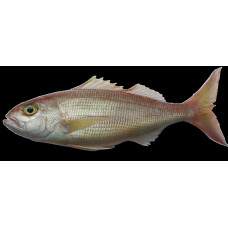Latin name
Pristipomoides filamentosus
Other names
Rosy snapper, bluespot jobfish, crimson snapper, king emperor, king snapper, rosy jobfish.
Identification
The body is elongated, somewhat compressed at the sides, relatively low; the body height at the level of the beginning of the dorsal fin is 3.3-3.6 times the standard body length. The tip of the upper jaw reaches the vertical line passing through the beginning of the eye. The interorbital space is flat. There are 22-26 gill rays on the first gill arch, 7-8 on the upper part and 15-18 on the lower part. There are scales on the gill cover. There are 60 to 65 scales on the lateral line. The dorsal scale rows run parallel to the lateral line.
Teeth
On both jaws, the anterior teeth are slightly enlarged, conical in shape, and the inner teeth are villous. There are teeth on the scutellum and palate. On vomer, the teeth are arranged in a stain triangular patch. The tongue is toothless.
Features of fish fins
One dorsal fin with 10 hard and 11-12 soft rays. The anal fin has 3 hard and 8 soft rays. The hard and soft parts of the fin are not separated by a notch. The last soft ray of the dorsal and anal fins is strongly elongated, noticeably longer than the other rays. There are no scales on the upper jaw, dorsal and anal fin membranes. The pectoral fins are long with 15-16 soft rays, their ends reaching the anus. The caudal fin is crescent-shaped.
Fish colouring
The body coloration is very variable. The back and sides can be brownish to lavender or reddish-purple. There are narrow yellow lines and blue spots on the snout and interorbital space (spots will darken during preservation). Dorsal and caudal fins are light blue or lavender with reddish-orange edges.
Distribution
Widespread in the Indo-Pacific from Hawaii and Tahiti to the east coast of Africa. In the western Pacific they are found from Australia (Queensland, New South Wales) and the Lord Howe and Norfolk Islands to southern Japan.
Habitat
Marine benthopelagic fish. They live near rocky reefs at depths of 80 to 360 meters.
Size
Maximum body length 100 cm, usually up to 50 cm. Maximum body mass 8.2 kg.
Behavior
At night, they make vertical migrations to the upper part of their habitat in search of food.
Food and feeding habits
The diet includes small fish, shrimp, crabs, amphipods, ascidians, and salps.
Reproduction
In Hawaii, they first mature at 2-3 years of age and spawn from March to December with a peak from May to September. Female mature at 36-38 cm body length and males at 40-42 cm body length. Of Seychelles they spawn from October to April with a peak in February to April and November. The maximum life expectancy is 40 years.
Fishing
It is a commercial fish in some regions. It is caught with hand lines and bottom longlines.
Relationship with a person
Sold fresh. It is considered a high quality food fish.
| Classification | |
| Phylum | Chordata |
| Class | Actinopterygii |
| Squad | Perciformes |
| Family | Lutjanidae |
| Genus | Pristipomoides |
| Species | P. filamentosus |
| Features | |
| Conservation status | Least Concern |
| Habitat | Pelagic |
| Life span, years | 40 |
| Maximum body weight, kg | 8,2 |
| Maximum length, cm | 100 |
| Sailing speed, m/s | No information |
| Threat to people | Edible |
| Way of eating | Predator |
Crimson jobfish
Tags: crimson jobfish

